Excerpts from Jim Conrad's
Naturalist Newsletter
entry dated January 9, 2023, issued from near Tequisquiapan, elevation about 1,900m (6200 ft), ~N20.57°, ~ W99.89°, Querétaro state, MÉXICO
LOESELIA COERULEA

At the edge of a small village, in very dry, weakly compacted dust and silt, in the bottom of a large pit where over the years fill-dirt has been removed, the above pale lilac flowers amazingly appeared on an apparently dead herbaceous, annual plant dried white and crisp by the drought and heat. The corollas were about 15mm long (0.6 inch), and emerged from what seemed to be white, papery calyxes prettily ornamented with brown, forking veins. The calyxes themselves were subtended by smaller modified leaves, or bracts. I'd not seen anything like this before, and it wasn't even clear what plant family I was dealing with, until I "did the botany."
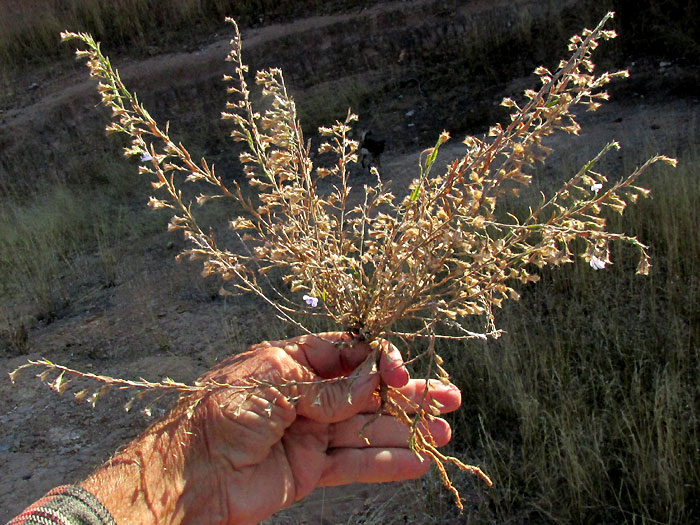
Above you can see that the dried-out plant still bore a few green sprouts. Also, notice that flowers arise along the stiff stems nearly all the way to the plant's base, which is quite unusual.
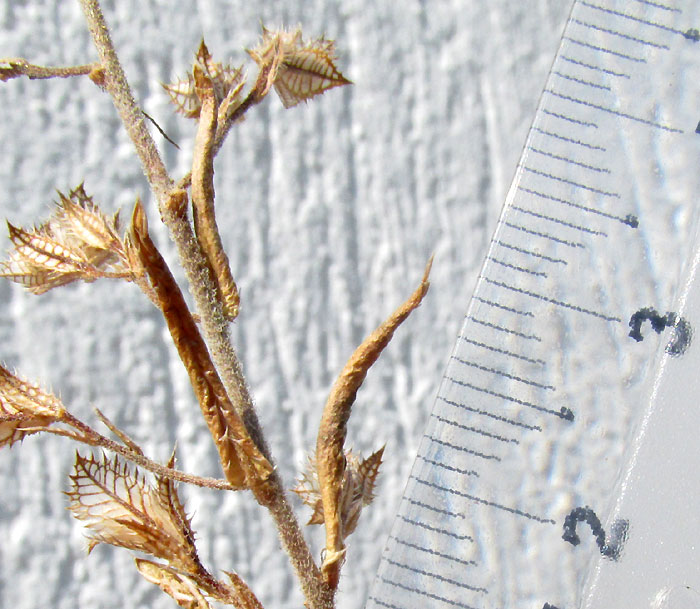
The above image shows that each slender, rough-hairy stem bears one leaf at each stem node, and these leaves are about 1.5mm long (0.6 inch) and bear short, broad-based, sharp-pointed hairs. Blade bases looked squared or even a little backward-lobed, or subcordate. And, doesn't it appear that each leaf shares its stem node with a peduncle of a cluster of flowers? More on that below.
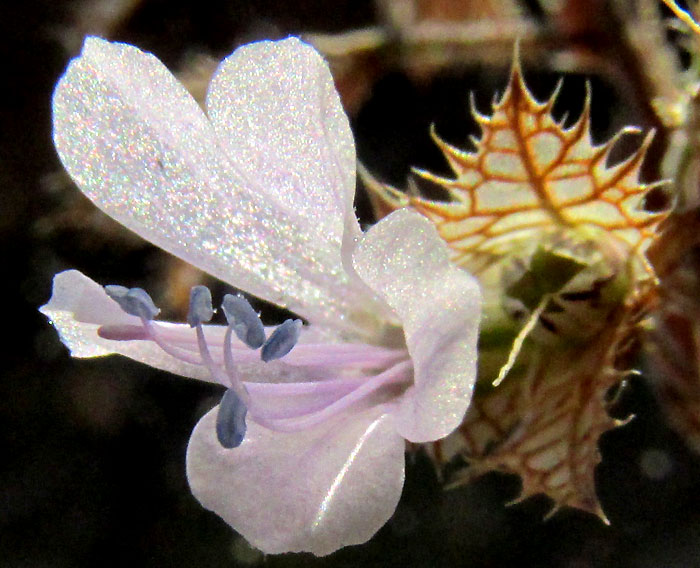
Both the corolla and the arrangement of the five stamens, display weakly bilateral symmetry. But, on the right of the corolla, what's that green, out-of-focus thing with something like a white thread issuing from its top? Below, the green thing is better seen:
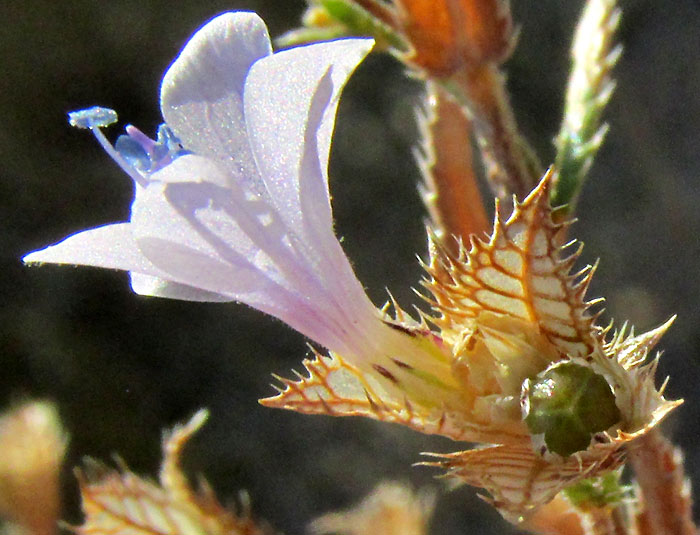
The green, pea-like object in the image's lower, right corner, formed after an earlier corolla fell off, is an immature, capsular-type fruit nestled in its white, papery, close-fitting, five-lobed calyx. Note that the fruit appears to consist of three interior partitions, forming three carpels, which is an unusual number for a dicot species like this. The presence of this immature fruit with its calyx, and what looks like yet other potential flower buds between the fruit and the flower, all surrounded by what earlier we assumed to be very pretty, spiny calyx lobes, indicates that what earlier seemed a flower with an especially ornamented, white-papery calyx, actually is a collection of flowers, blooming one at a time, forming an inflorescence. What seemed to be a calyx is an involucre formed of modified leaves, or bracts.
Before asking the question of which plant family brings together all the above features, here's a closer look at our plant's almost-woody, many-branched base:
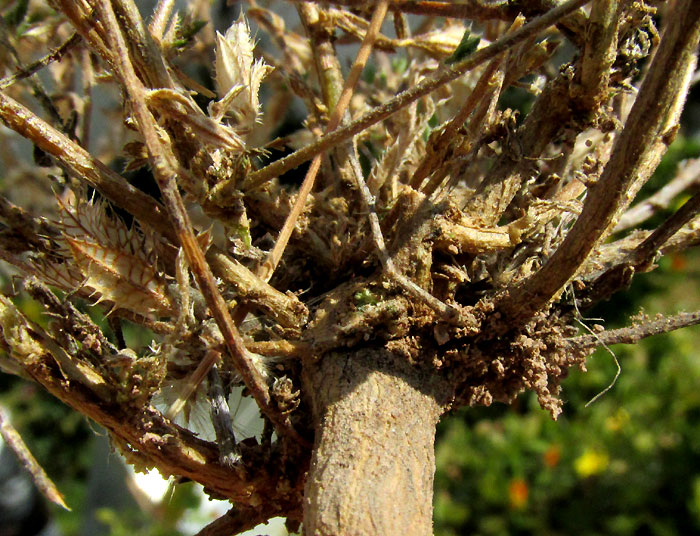
Despite the bracts and bilateral corolla symmetry, our plant isn't in the Acanthus Family, whose flowers usually produce two or four stamens, not five. Despite its flowers grouped within a calyx-like involucre of bracts, it doesn't belong to the Four-O'clock Family, in which the calyx looks like a corolla, but there is no corolla. To discover the family, I had to resort to LucidCentral.Org's online, interactive, Key to Neotropical Plant Families.
Result: The Phlox Family, Polemoniaceae, in which the best known plant to northerners probably are the various phlox species, and Jacob's Ladder. Botanically, the main feature distinguishing this family from look-alike ones is the ovary and fruit with their three carpels.
In our area, if your Phlox-Family member has a corolla less than 3.5cm long (1.4 inch), and the flowers are surrounded by an involucre of bracts, you have the genus Loeselia, consisting of about 16 species distributed from along the US border with northwestern Mexico, south through Mexico to northwestern South America. And if you have a Loeselia of which the bracts forming the floral involucre are oval or broader, and the leaves appear nearly entirely one at each stem node, not two or more, then you have LOESELIA COERULEA.
Loeselia coerulea, which has no commonly used English name, is endemic to the arid and semiarid, upland regions of Mexico, from near the US border in north-central Mexico south to Oaxaca, and normally is seen in grasslands and heavily disturbed scrub areas, like the bottom of our fill-dirt pit. It's fairly commonly encountered, and the vast majority of Internet pictures of it show green, hairy plants, so our bleached-white plant is a late-season oddity, and such a plant bearing fresh blossoms, I think, must be fairly mind-boggling to anyone familiar with plants in general.
The fascinating Atlas de las Plantas de la Medicina Tradicional Mexicana -- Atlas of Mexican Traditional Medicinal plants -- describes the entire plant being used to make infusions and rub-on pomades to cure burning urination and for bladder problems. The plant is used together with the Amaranth Family species known in North America as the Pearly Globe-Amaranth, Gomphrena nitica. In Oaxaca, the plant is used to treat espanto, a special kind of fright which we might refer to as persisting, debilitating depression and worry.